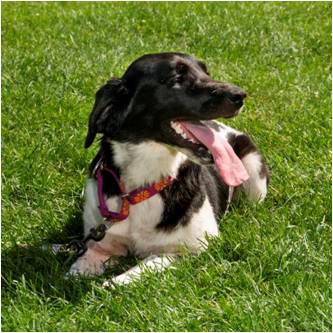Heatstroke occurs when a dog is unable to adequately dissipate body heat; body temperature can reach very elevated levels, which can result in major damage to organ systems and, ultimately, death. When ambient temperatures climb, it becomes more difficult for a dog to regulate its body temperature, increasing the risk of problems; this is especially true as outside temperatures approach (or exceed) body temperature.
The risk is even greater in dogs that have less ability to control their body temperature, including obese animals, certain breeds with “smooshed’ faces (such as bulldogs), very young or very old animals, or animals with underlying airway problems. Other factors that can limit a dog’s ability to dissipate heat include inadequate water availability, poor ventilation, and high humidity. Increased heat production is also a risk factor; aside from elevated body temperature due to disease, exercise (especially when other risk factors are present) can make it harder for the body to regulate temperature.
Initial symptoms of heatstroke may involve excessive panting and drooling. As the situation worsens, lethargy, poor coordination, vomiting and/or diarrhea (sometimes with blood), collapse, seizures and cardiac arrest can all occur. These symptoms warrant immediate attention, especially when risk factors for heat stroke are present. Move a dog with these symptoms to a cool, shaded area and call a veterinarian immediately. In some situations, it may be best to attempt to reduce the dog’s body temperature prior to transporting to a veterinarian; but in other cases, it may be best to get to the veterinarian immediately – follow the advice of a veterinarian based on your specific situation. If it is recommended to try and reduce the dog’s temperature prior to transport, you can wet him with luke-warm or cool (but not cold) water and/or place him in the breeze of a fan. If the dog is able to drink, offering small amounts of cool water should also be done.
Preventing this potentially life-threatening problem is based, first and foremost, on limiting the risk of exposure to excessive temperatures. Dogs should never be left alone in hot parked cars (even if you’re in the shade or will only be gone a short time). Remember that temperatures inside these cars can exceed the temperature outside, even by as much as 30°F or more, in a matter of minutes. For dogs that are outside, make sure there is consistent access to shade. Avoid places like the beach, concrete, and asphalt areas where heat is reflected, and if the temperature is getting too high, bring your dog inside (especially if air conditioning is available). All dogs should have free access to drinking water and be able to freely pant (no muzzles). Avoid strenuous exercise during periods of excessive heat, and be especially mindful of pets that are more at risk for heatstroke.




